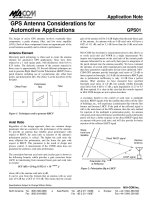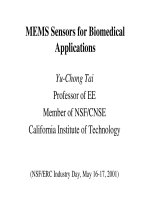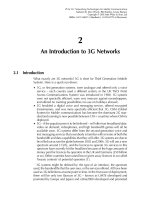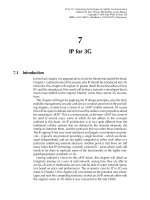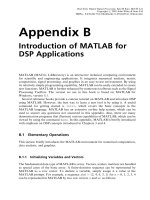TITANIUM ALLOYS – TOWARDS ACHIEVING ENHANCED PROPERTIES FOR DIVERSIFIED APPLICATIONS pdf
Bạn đang xem bản rút gọn của tài liệu. Xem và tải ngay bản đầy đủ của tài liệu tại đây (18.23 MB, 240 trang )
TITANIUM ALLOYS –
TOWARDS ACHIEVING
ENHANCED PROPERTIES
FOR DIVERSIFIED
APPLICATIONS
Edited by A.K.M. Nurul Amin
Titanium Alloys – Towards Achieving Enhanced Properties for
Diversified Applications
A.K.M. Nurul Amin
Published by InTech
Janeza Trdine 9, 51000 Rijeka, Croatia
Copyright © 2012 InTech
All chapters are Open Access distributed under the Creative Commons Attribution 3.0
license, which allows users to download, copy and build upon published articles even for
commercial purposes, as long as the author and publisher are properly credited, which
ensures maximum dissemination and a wider impact of our publications. After this work
has been published by InTech, authors have the right to republish it, in whole or part, in
any publication of which they are the author, and to make other personal use of the
work. Any republication, referencing or personal use of the work must explicitly identify
the original source.
As for readers, this license allows users to download, copy and build upon published
chapters even for commercial purposes, as long as the author and publisher are properly
credited, which ensures maximum dissemination and a wider impact of our publications.
Notice
Statements and opinions expressed in the chapters are these of the individual contributors
and not necessarily those of the editors or publisher. No responsibility is accepted for the
accuracy of information contained in the published chapters. The publisher assumes no
responsibility for any damage or injury to persons or property arising out of the use of any
materials, instructions, methods or ideas contained in the book.
Publishing Process Manager Ana Skalamera
Technical Editor Teodora Smiljanic
Cover Designer InTech Design Team
First published March, 2012
Printed in Croatia
A free online edition of this book is available at www.intechopen.com
Additional hard copies can be obtained from
Titanium Alloys – Towards Achieving Enhanced Properties for Diversified Applications,
Edited by A.K.M. Nurul Amin
p. cm.
ISBN 978-953-51-0354-7
Contents
Preface IX
Part 1 Manufacturing Processes and
Inherent Defects in Titanium Parts 1
Chapter 1 Numerical Modeling of the Additive
Manufacturing (AM) Processes of Titanium Alloy 3
Zhiqiang Fan and Frank Liou
Chapter 2 Formation of Alpha Case Mechanism
on Titanium Investment Cast Parts 29
Si-Young Sung, Beom-Suck Han and Young-Jig Kim
Chapter 3 Genesis of Gas Containing
Defects in Cast Titanium Parts 42
Vladimir Vykhodets, Tatiana Kurennykh and Nataliya Tarenkova
Part 2 Properties of Titanium Alloys Under High
Temperature and Ultra High Pressure Conditions 65
Chapter 4 Titanium Alloys at Extreme Pressure Conditions 67
Nenad Velisavljevic,
Simon MacLeod and Hyunchae Cynn
Chapter 5 Hot Plasticity of Alpha Beta Alloys 87
Maciej Motyka, Krzysztof Kubiak,
Jan Sieniawski and Waldemar Ziaja
Chapter 6 Machinability of Titanium Alloys in Drilling 117
Safian Sharif, Erween Abd Rahim and Hiroyuki Sasahara
Part 3 Surface Treatments of Titanium Alloys for
Biomedical and Other Challenging Applications 139
Chapter 7 Chemico-Thermal Treatment of
Titanium Alloys – Nitriding 141
Iryna Pohrelyuk and Viktor Fedirko
VI Contents
Chapter 8 Anodic Layer Formation on Titanium
and Its Alloys for Biomedical Applications 175
Elzbieta Krasicka-Cydzik
Chapter 9 Surface Modification Techniques for Biomedical
Grade of Titanium Alloys: Oxidation, Carburization
and Ion Implantation Processes 201
S. Izman, Mohammed Rafiq Abdul-Kadir,
Mahmood Anwar, E.M. Nazim, R. Rosliza,
A. Shah and M.A. Hassan
Preface
Though titanium and its alloys are relatively new engineering materials, they have
found wide application in the aerospace, shipbuilding, automotive, sports, chemical and
food processing industries due to their extreme lightness, high specific strength and
good corrosion resistance at temperatures below 500
o
C. They are also considered
suitable materials for biomedical application due to their biological passivity and
biocompatibility. However, besides these positive properties titanium alloys have a
number of adverse favorable properties which are related to their processing,
machinability and long time use in open and corrosive environment. Chemical reactivity
of titanium with other materials at elevated temperature is high, which necessitates the
development of non conventional melting, refining and casting techniques, making this
material very expensive. Numerous research is directed towards addressing these issues
in order to ease their processing and further applications.
This nine diverse chapters of this book are distributed under three sections and
address problems related to the processing and application of this precious metal and
its alloys. The book chapters are contributed by researchers who devoted long periods
of their research career working on titanium and its alloys looking for solutions to
some of these specific problems From this perspective this book will serve as an
excellent reference material for researchers whose works is in anyway related to
titanium and its alloys - from processing to applications. The chapters are designed to
address the issues that arise at the material development, processing and the
application stages. For instance, the α case formation defects that arise at the
investment casting stage and the optimization aspects of the additive manufacturing
(AM) processes through numerical modelling and simulation has been addressed in
two different chapters. Similarly, the metallurgical defects resulting from entrapped
gases during casting processes are common to titanium parts. T
he morphology of
formation of these defects in the
production of
Ti–6Al–4V alloy is presented in
another chapter of the book with the objective of addressing effectively the problem
at the casting stage
.
Titanium parts are sometimes designed to work as die
components or as projectiles and as such are subjected to high pressures and
temperatures. However, high pressure raises a number of scientific and engineering
issues, mainly because under such pressures the relatively ductile phase may get
transformed into a fairly brittle ω phase, which may significantly limit the use of
titanium alloys in high pressure applications. One of the chapters of the book deals
X Preface
with these issues and indicates how the formation of ω phase may be avoided through
adoption of proper processing techniques.
In the Chapter ‘Hot Plasticity of alpha Beta alloys’ the authors have shared their
invaluable experimental results explaining different aspects of hot plasticity of two-
phase titanium alloys and have indicated techniques for developing appropriate
microstructure yielding optimum plastic flow stresses under elevated temperatures. The
phenomenon of super plasticity is also addressed in the same chapter. Furthermore,
application of titanium alloys under corrosive environment and friction requires
additional strengthening through effective surface treatment. One chapter of the book
addresses different aspects of a common chemico-thermal method - nitriding to apply an
effective coating on titanium parts. Specific issues related to the intricacies of the
nitriding process suitable for application on titanium parts have been elaborated in the
same chapter with excellent illustrations. Titanium alloys are common options in
biomedical and dental applications and the ternary alloys Ti-6Al-7Nb are widely used
for these purposes due to their unique mechanical and chemical properties, excellent
corrosion resistance and biocompatibility. Development of nanotube anodic layers for
medical applications on these materials are addressed in one of the chapters while the
mechanism of electrochemical deposition of calcium phosphate on titanium substrate
and the related process parameters and optimization techniques are presented in
another. Titanium and its alloys are well known for their poor machinability properties.
Useful experimental materials are presented in one chapter dealing with machining of
titanium alloys, specifically drilling, a common machining operation.
We hope the research materials presented in the different chapters of this book will
contribute to the ongoing research works on titanium and its alloys and help further
improvement in the properties and application of titanium alloys.
Acknowledgements
The Editor would like congratulate the publishing team of INTECH for taking up this
vital project and successfully steering it through its various reviewing, editing and
publishing stages. Deep appreciation is extended to all the authors of the book
chapters for their contribution in composing this valuable book. He would also like to
acknowledge his deep appreciation to the Publishing Process Managers of the book for
their sincere cooperation in rendering Editor's duties during the entire period of the
editing and compilation process. Finally, he would like to express his gratefulness to
the publisher for choosing him as the Editor of this book.
Prof. Dr. A.K.M. Nurul Amin
Department of Manufacturing and Materials Engineering,
Faculty of Engineering, International Islamic University of Malaysia,
Malaysia
Part 1
Manufacturing Processes and
Inherent Defects in Titanium Parts


